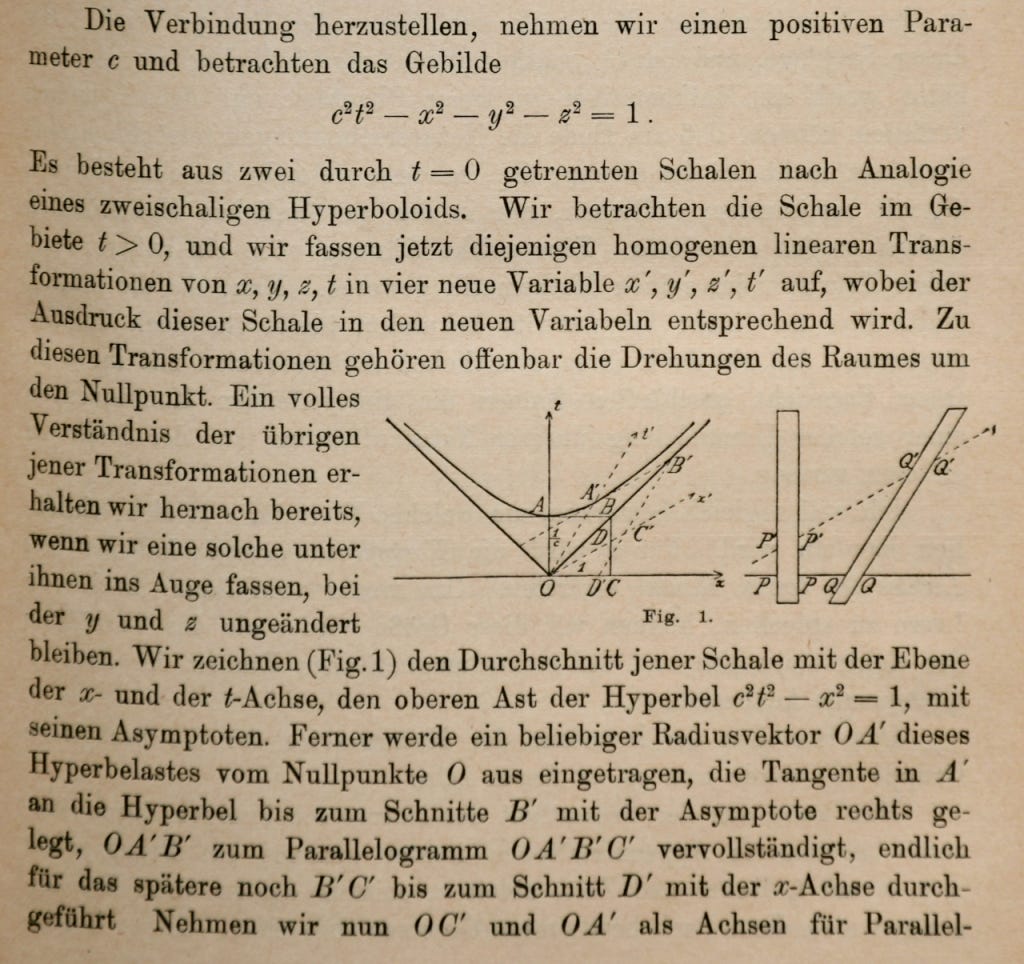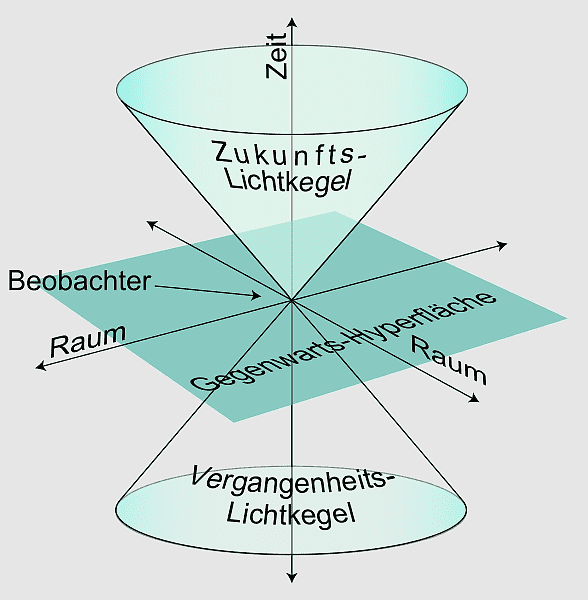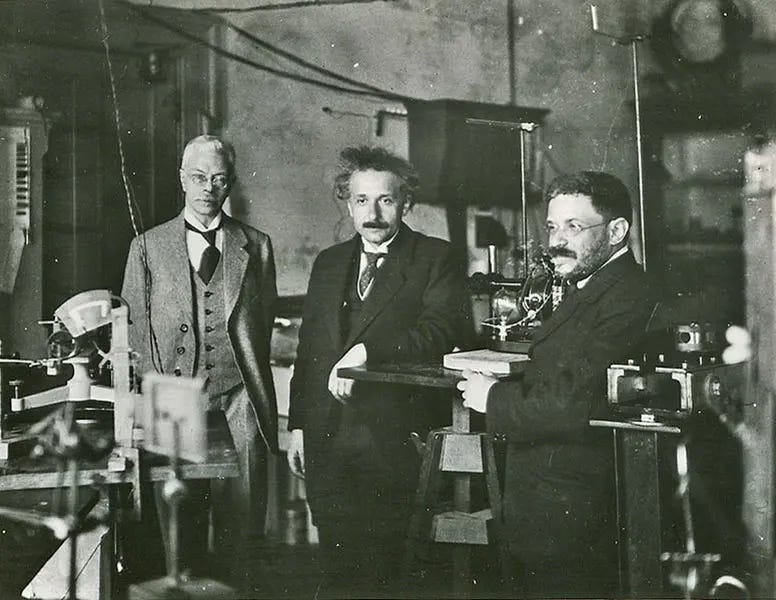The Relativistic Energy of Light
And the imaginary shape of the electron
Weirdly enough, the final pages (section 8) of Einstein’s 1905 relativity paper, relate to the energy of light. Miller (in Albert Einstein’s Special Theory of Relativity) observes (page 309) that these three pages are Einstein’s tour de force:
In the three pages of section 8, Einstein deduced the energy of a light complex (a relativistic blob of light – not explicitly a light quantum), and then solved exactly the problems of determining the characteristics of plane waves incident on a perfectly reflecting surface that is in inertial motion with velocity v, and of calculating the pressure of light on this surface.
And that’s not all, as Miller notes on page 311, he also notes how the energy of the light complex relates to other spacetime frames and that the ratio of wavelength (frequency) to energy is always the same.
Of course, Einstein had already proposed the light quantum in another paper (on the photo-electric effect) in 1905. A similar notion occurs in section 8 of the relativity paper as the relation between different pulses of light so he briefly covers the same ground (of light energy) from a slightly different, less “revolutionary” angle. Einstein regarded the light quantum as the more “revolutionary” of the two proposals and he seems to have been right. The core group of particle physicists had accepted relativity by 1911, but the light quantum was not generally accepted until the late 1920s even by that core group. So relativity was accepted in six years and the light quantum – not for around 20 years. For that matter, General Relativity was accepted around a decade before the light quantum. I hope not to go much into General Relativity – I’m hoping to head into the light quantum as soon as relativity and the aether are eased into their relatively final historical roles — one steadily replacing the other phenomenologically in the experimental realm.
Things are getting close to finishing the trajectory of the electron through the earliest stages of the acceptance of special relativity and it’s time to reflect on how much of what I now see about this acceptance and the electron and the end of the aether is based on A. I. Miller’s book from 1981, Albert Einstein’s Special Theory of Relativity: Emergence (1905) and Early Interpretation (1905-1911) – well, really almost everything. Miller’s book is quite amazing, but we will be getting beyond 1911 here soon.
In 1906, Einstein’s attention was more on the energy of light and its absorption than on questions surrounding the (what we would think of as the relativistic) mass of the electron. In 1906, both he and Ehrenfest noted the relation of Planck’s constant to the energy of light (as Kuhn describes on pages 152 to 187 of Black-Body Theory and the Quantum Discontinuity ). And we now take up the story as described by Miller following page 234.
After puzzling over how Planck’s constant fitted into the energy of light, Ehrenfest wondered about how a Lorentz-contracted electron could accelerate in a curved trajectory given Abraham’s 1903 proof that a rigid, charged sphere could only accelerate without stress if it went directly along one central axis. It seemed to Ehrenfest that you could not have relativity and deformable (ie Lorenz-contracted) electrons in the same theory. Einstein’s paper in answer to Ehrenfest’s paper suggested it was better for the overall coherence of theory and explanation to move from the principles of relativity and the energy of light to let the forces acting on the electron be fitted to the electron as needed to keep it working rather than proposing that if one model of the electron had problems then all theories had to be considered void. Maybe there were stresses involved in the electron (as Kaufmann had noted in 1906 as Poincaré’s “unknown universal exterior pressure”).
In his next paper of 1907 (the fourth, 1907d), Einstein took up Planck’s designation of Einstein’s theory: “Relativity Theory” and noted that if you went faster than light, you’d be going back in time. At about this same time, Minkowski worked out the complete geometry of relativistic spacetime (ie as idealized without the curvatures of General Relativity), attributing the basic postulate (the interrelation of coordinate systems each infinitesimally simulating a small chunk of a static aether, ie, an inertial frame) to Lorentz and the principles to Einstein’s new concept of time. After Minkowski’s death in 1909, it was Sommerfeld (in two papers from 1910) who explained the geometry (with its physical implications) and invented the term “four-vector” (Viervektor).
So what about four-vectors? Sommerfeld named those vectors (with 4 dimensions and imaginary time as invented by Poincaré ) and we have very much inherited his view of Einstein as the person who first made it clear that those slices of aether with their different times could not be related to some absolute other time elsewhere in the absolute space of the aether. Galina Weinstein noted in her paper “Max Born, Albert Einstein and Hermann Minkowski’s Space-Time Formalism of Special Relativity” (arxiv, 2012) that Sommerfeld carefully edited (in 1915) the publication of Minkowski’s earliest lecture on relativity (from 1907) so that it conformed to what Sommerfeld (and everyone else since then who has looked into Minkowski Space quite correctly if not so heavy-handedly) believed to be true: Einstein was the first to state the implications of the situation that there was no absolute time and no absolute aetherial space in which to place that other time outside of local time, despite the interest of Minkowski and others in explicating all traces of the Lorentzian aether.
Minkowski did point out the solution to the problem of the rigid versus the non-rigid electron: In the Einsteinian formulation, if you are riding on what looks like a Lorentz contracted electron to others (ie a non-rigid electron), to you, your electron looks undeformed – your little chunk of spacetime, your little inertial frame, seems “rigid.” So far, so good. In 1909, Ehrenfest described another paradoxical situation involving relativistic motion – the Ehrenfest Paradox – which proved useful for Einstein in thinking through General Relativity. The full structure of the paradox was not completely clarified until 2002 (see Wikipedia “Ehrenfest Paradox”). Fortunately for my mathematical limitations, this blog will be hurrying on toward mesons via the energy of the electron and on toward atomic models with a swerve back toward the Compton Effect so as to observe the impact of Cosmic Rays on the small world of particle physics in the 1930s.
Well, as we now know, the blog never made it to the 1930s. Eventually, however, I think that (after dealing with Dirac and the Klein-Nishina Formula for the Compton Effect) we can look at Cosmic Ray events from the 1930s with the proper level of consternation here on Substack someday.





